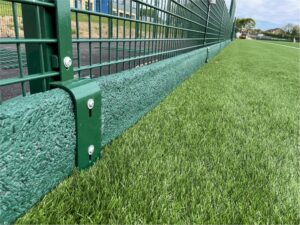New European Studies Confirm Crumb Rubber Safety in Artificial Turf
Studies outline simple, cost-effective turf maintenance practices and perimeter containment systems
A pair of newly released studies from European experts in the United Kingdom and Denmark looked into the safety of artificial turf using recycled rubber— in particular, how often the infill escaped containment.
Both studies came to a similar conclusion: crumb rubber infill is safe for the environment with smart and simple maintenance practices and perimeter containment systems.
In a recent United Kingdom government report titled “Option Appraisal for Intentionally Added Microplastics”, researchers looked closely at ways to contain existing fences to prevent loose granules from escaping, and perimeter boards to prevent seasonal infill migration.
Alongside these containment measures, turf fields limit the use of pesticides and fertilizers, and recycled rubber keeps more than 220 million tires out of landfills each year, the study said.
 Similarly, the Danish Technological Institute ran a comprehensive study at a local sports facility, measuring how much rubber material escapes well-designed turf fields. They tested, among other factors, drainage water contamination, equipment transport emissions, and the travel of materials across barriers.
Similarly, the Danish Technological Institute ran a comprehensive study at a local sports facility, measuring how much rubber material escapes well-designed turf fields. They tested, among other factors, drainage water contamination, equipment transport emissions, and the travel of materials across barriers.
They found that, with proper containment measures, infill dispersal can be limited to less than 10kg per year. These measures include, physical barriers around the field, dedicated cleat cleaning stations as players, coaches and others leave the field and drainage protection, including drainage collection wells and membrane fields installed underneath the turf to drain water
These measures offer a blueprint for what cost-effective turf infrastructure can look like, ensuring longevity and keeping the turf fields safe for the environment.
The studies underscore what we already know: using recycled rubber in recreation spaces is safe and sustainable, the Better Play Initiative’s (BPI) Scott Gerber said in reporting on the studies as part of its continuing education initiative.
If the goal is science-based policy, studies like this deserve a closer look. This research adds to the growing body of data supporting recycled rubber’s safety for both humans and the environment.
© Scrap Tire News, July 2025






